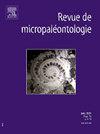美国堪萨斯州 Excello 页岩中的 Desmoinesian(宾夕法尼亚中期)放射虫
IF 1
Q4 PALEONTOLOGY
引用次数: 0
摘要
在美国堪萨斯州东南部(K69剖面)的Fort Scott石灰岩(Marmaton群)的Excello页岩段地层中发现的黑色磷酸盐相碳酸盐结块中发现了德蒙因世(中宾夕法尼亚)放射虫。报道了10个放射虫新种:kansaalbaillella, Holdsworthella trifurca, Pseudoalbaillella deformata, Entactinia jayhawkensis, E. heckeli, E. boardmani, Apophysiacus martiali, Moskovistella solinita, Palacantholithus umbrelliformis和Ormistonella perrara。堪萨斯州放射虫组合在保存和分类组成上与爱荷华州Excello页岩所描述的组合不同。放射虫被保存为黄铁矿化的内部模具或由黄铁矿代替的常规测试,以及无法识别的有机物质。在堪萨斯组合中占主导地位的是entactinarians和albaillellarians,它们的保存状况从差到好表明在缺氧条件下形成早期成岩钙质结块。刺状放射虫属Palacantholithus的出现表明与上升流有关的相对冷水的流入。与爱荷华州相比,堪萨斯州的位置离岸更远(向盆地450公里),这表明温跃层深度的差异,影响了水温、氧合和营养。本文章由计算机程序翻译,如有差异,请以英文原文为准。
Desmoinesian (middle Pennsylvanian) radiolarians from the Excello Shale of Kansas, USA
Desmoinesian (Middle Pennsylvanian) radiolarians are described from carbonate concretions found in the black phosphatic facies in strata of the Excello Shale Member of the Fort Scott Limestone (Marmaton Group) in southeastern Kansas (K69 section), USA. Ten new species of radiolarians are described: Albaillella kansaensis, Holdsworthella trifurca, Pseudoalbaillella deformata, Entactinia jayhawkensis, E. heckeli, E. boardmani, Apophysiacus martiali, Moskovistella insolita, Palacantholithus umbrelliformis, and Ormistonella perrara. The Kansas radiolarian assemblage is different from the assemblage described from the Excello Shale of Iowa in the preservation and taxonomic composition. The radiolarians are preserved as pyritized internal molds or regular tests replaced by pyrite, and unidentifiable organic material. The domination of entactinarians and albaillellarians in the Kansas assemblage and their poor to excellent preservation indicate the formation of early diagenetic calcareous concretions in anoxic conditions. The appearance of the spicular radiolarian genus Palacantholithus indicates an influx of relatively cold water connected with upwelling. The Kansas location was much farther offshore (450 km basinward) compared to the Iowa localities suggesting a difference in thermocline depth, affecting water temperature, oxygenation, and nutrients.
求助全文
通过发布文献求助,成功后即可免费获取论文全文。
去求助
来源期刊

REVUE DE MICROPALEONTOLOGIE
PALEONTOLOGY-
CiteScore
2.50
自引率
0.00%
发文量
17
期刊介绍:
La Revue de micropaléontologie publie 4 fois par an des articles de intérêt international, consacrés à tous les aspects de la micropaléontologie. Les textes, en anglais ou en français, sont des articles originaux, des résultats de recherche, des synthèses et mises au point, des comptes rendus de réunions scientifiques et des analyses de ouvrages. La revue se veut résolument ouverte à tous les aspects de la micropaléontologie en accueillant des travaux traitant de la systématique des microfossiles (et de leurs équivalents actuels), des bactéries aux microrestes de vertébrés, et de toutes leurs applications en sciences biologiques et géologiques.
 求助内容:
求助内容: 应助结果提醒方式:
应助结果提醒方式:


